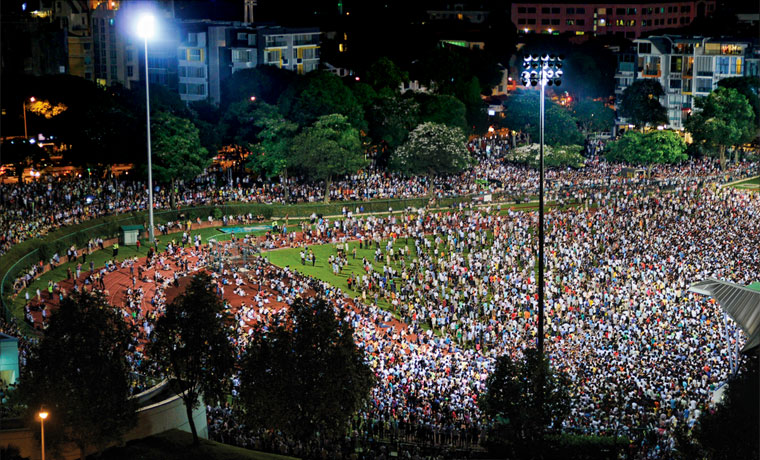To torture myself because it is Monday and fulfill my patriotic duty, I read the following articles published in The Sunday Times on July 19, 2015, pertaining to the impending electoral boundary changes to make myself a better-informed citizen:
Boundary changes: What's in line this coming General Election?
Which constituencies may face changes?
Will Potong Pasir remain a single-seat ward?
Will six-member GRCs be a thing of the past?
Here is what I learnt (Executive summary):
In Singapore, each Member of Parliament is meant to theoretically serve and represent between 20,000 to 36,000 voters. The standard deviation is set at 30 percent, a rule introduced in 1980.
The General Election is where one vote can usher in between one and six MPs into parliament, depending on whether the voter is voting in a Single-Member Constituency or Group Representation Constituency.
Electoral boundaries are man-made, can be cut to better the chances of increasing a particular party's vote share and even though the number of eligible voters is one of the criteria for how boundaries are cut and reformed, the science and statistical rationale to inform or govern the process of shifting boundaries is junk at worst, and politically-expedient pseudo-science at best.
And here are 10 things you are better off knowing about the politics of gerrymandering in Singapore before the upcoming General Election, widely expected to be held in 2015.
1. Aljunied GRC, with its current boundaries, had absorbed parts of Kaki Bukit ward of Marine Parade GRC. That area had about 27 percent Malay residents, higher than the national average of 14 percent. Malay residents traditionally tend to vote for the PAP. But Aljunied was still lost to the Workers' Party in GE2011.
2. Aljunied GRC is expected to go untouched. Previously, opposition-held constituencies Hougang and Potong Pasir boundaries stayed intact for many years. The expectation is that opposition-held divisions will be left untouched.
3. Hougang SMC is predicted to be left intact this coming GE as the PAP will not win it back.
4. In 2011, Ang Mo Kio GRC and Pasir Ris-Punggol GRC absorbed parts of Aljunied-Hougang ward. Workers' Party speculated that the seven polling districts Aljunied GRC lost to Prime Minister Lee Hsien Loong's Ang Mo Kio GRC enjoyed stronger opposition support.
5. Potong Pasir SMC is the smallest with only 17,285 voters. It was preserved as it was as part of the incumbent's politics of containment, as Singapore People's Party's Chiam See Tong held the seat for 27 years. It looks set to be absorbed now that it has been won back by the PAP.
6. Joo Chiat SMC is an anomaly as it is the only constituency without a block of Housing Board flats in its midst. There is no compelling reason why it was allowed to remain as an SMC in GE2011 other than historical legacy.
7. Parts of pro-Workers' Party Punggol East SMC could be hived off into a new GRC as it is deemed to have hit the upper limit of voters per MP as it currently has 34,398 voters.
8. Parts of Marine Parade GRC, which was labelled an "oddly shaped constituency" -- a subtle acknowledgement of the effects of gerrymandering -- could be carved out to expand Joo Chiat SMC and provide it with voters staying in HDB flats.
9. Six-member GRCs first appeared in 1997. There were four of them. The reason was that they were set up to pave the way for the creation of community development councils which would oversee grassroots organisations and help manage public assistance schemes.
10. However, in the 2001 and 2006 elections, there were five such constituencies and only two were retained in the 2011 election.
And here are 5 things I didn't learn and probably never will:
i. Why should one vote be used to vote in as many as 4, 5 or 6 MPs?
ii. How does one explain the demise of the six-member GRCs but the continuing functioning of community development councils? (Relating to points 9 and 10 above.)
iii. What is the justification for having one six-member Ang Mo Kio GRC instead of six single-member constituencies in Ang Mo Kio?
iv. If three-member GRCs are re-introduced, how will minorities be represented or will they be over-represented?
v. How is it justifiable that an MP who serves 17,385 voters (PAP Sitoh Yih Pin, Potong Pasir SMC) is paid the same as another MP who serves 34,398 voters (WP Lee Li Lian, Punggol East SMC)?
Top photo via
If you like what you read, follow us on Facebook and Twitter to get the latest updates.
If you like what you read, follow us on Facebook, Instagram, Twitter and Telegram to get the latest updates.
